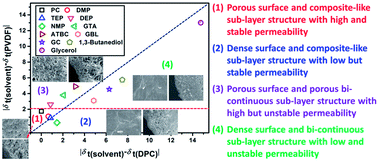Tailoring both the surface pore size and sub-layer structures of PVDF membranes prepared by the TIPS process with a triple orifice spinneret†
Abstract
In this study, the surface and sub-layer structures of poly(vinylidene fluoride) (PVDF) membranes were effectively tailored by extruding different types of solvents at the outer layer of the polymer solution with a triple-orifice spinneret using the thermally induced phase separation (TIPS) process. The segregation of the diluent or PVDF chains to the interface between the extruded solvent and polymer solution was exploited to tailor the membrane surface structure. In contrast, the diffusion of extruded solvents having good compatibility with PVDF into the polymer solutions changed the phase separation mechanism and resulted in the formation of a novel composite-like structure (spherules connected by the bicontinuous network structure) in the sub-layer of the membrane. This membrane structure enhanced the permeation stability drastically. The membrane properties and structures are summarized based on the change in the competitive ternary interactions between the polymer, diluent, and extruded solvent, and could be used as a guide for selecting appropriate solvents to design and tailor membranes with desired structures and properties.



 Please wait while we load your content...
Please wait while we load your content...